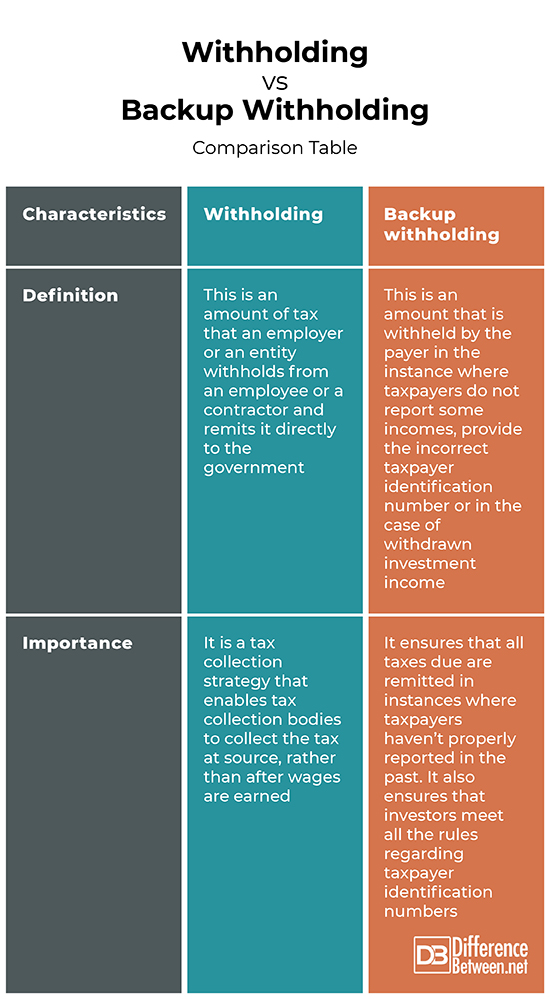Difference Between Withholding and Backup Withholding
Taxation mistakes can be costly for both individuals and businesses. Businesses that fail to remit their taxes to the relevant authorities may even be forced to shut down when they are unable to pay their taxes, interest and penalties. As for individuals, tax evasion attracts hefty fines and even jail time. This is why individuals and other ventures are always encouraged to get the services of a qualified professional. There are many ways that tax authorities use to enforce tax collection, and some of these include withholding and backup withholding. But what is the difference between these two? Let’s discuss this below.

Withholding
Withholding tax is an amount of money that an employer or an entity withholds from an employee or a contractor and remits it directly to the government. Withholding tax is a tax collection strategy that enables tax collection bodies to collect the tax at source, rather than after wages are earned. This means that the contractor or employee is paid less the tax withheld, with the remaining tax paid after the wages are earned. In instances that too much tax is withheld, the employee or contractor is entitled to a tax refund.
The first tax withholding occurred in 1862 in the United States. It was ordered by President Abraham Lincoln in a bid to finance the civil war. And now, it is deducted from wages, salaries and dividends of the income tax liability. The withholding amount is then credited against the income tax liability, thereby reducing the amount of tax payable.
Countries have varying withholding tax stipulations. For instance, In Canada, 25% of interest, rents, dividends, royalties, technical and management fees made by both Canadian residents and non-residents is withheld where applicable.

Backup Withholding
This is a tax that is withheld by the payer when taxpayers do not report some incomes, provide the incorrect taxpayer identification number or in the case of withdrawn investment income. It is levied at an established rate. Backup withholding helps tax collection agencies such as the Canada Revenue Agency to receive income tax from investors’ earnings that they may have already spent before the tax bill is due. The backup withholding tax is remitted to the relevant tax authorities at the time when an investor withdraws their investment income. This provides the government with the stipulated investors’ funds, leaving the investor with less cash flow.
Backup withholding applies to interest payments, third party network & payment card transactions, dividends, profits, rents & other gains, patronage dividends where applicable, payments made to independent contractors, royalty payments, barter exchange/ brokerage payments, fishing boat operators’ payments where applicable, original issue discounts, gambling winnings and some government payments. Backup withholding does not apply to real estate transactions, cancelled debts, benefits derived from long-term care, cancelled debts, abandonments and foreclosures, retirement amount distributions, unemployment compensation and other applicable payments.
Backup withholding can be prevented by providing the required tax information such as the correct taxpayer identification number, filing the missing tax returns and paying the amount owed.
Similarities between Withholding and Backup Withholding
- Both withhold a certain amount from individual taxpayers or businesses
Differences between Withholding and Backup Withholding
Definition
Withholding tax is an amount of tax that an employer or an entity withholds from an employee or a contractor and remits it directly to the government. On the other hand, backup withholding is an amount that is withheld by the payer in an instance where taxpayers do not report some incomes, provide the incorrect taxpayer identification number or in the case of withdrawn investment income.
Importance
Withholding is a tax collection strategy that enables tax collection bodies to collect the tax at source, rather than after wages are earned. On the other hand, backup withholding ensures that all taxes due are remitted in instances where taxpayers haven’t properly reported in the past. It also ensures that investors meet all the rules regarding taxpayer identification numbers.
Withholding vs. Backup Withholding: Comparison Table

Summary of Withholding vs. Backup Withholding
Withholding tax is an amount of tax that an employer or an entity withholds from an employee or a contractor and remits it directly to the government. On the other hand, backup withholding is an amount that is withheld by the payer in instance where taxpayers do not report some incomes, provide incorrect taxpayer identification number or in the case of withdrawn investment income.
FAQs
Is backup withholding bad?
Yes. Backup withholding is bad. However, it can be resolved by either providing the required tax information such as the correct taxpayer identification number, filing the missing tax returns or paying the amount owed.
How do I know if I am not subject to backup withholding?
If you provide the correct taxpayer identification number and always report the correct dividend, interest, patronage dividend income and other applicable remittances.
What accounts are subject to backup withholding?
Backup withholding is subject to interest payments, third party network & payment card transactions, dividends, profits, rents & other gains, patronage dividends where applicable, payments made to independent contractors, royalty payments, barter exchange/ brokerage payments, fishing boat operators’ payments where applicable, original issue discounts, gambling winnings and some government payments.
- Difference Between Profit Center and Investment Center - July 2, 2022
- Difference Between Anti-Trust and Anti-Competition - June 6, 2022
- Difference Between Stocktaking and Stock Control - June 6, 2022
Search DifferenceBetween.net :
Leave a Response
References :
[0]United States. Internal Revenue Service. Backup Withholding on Missing and Incorrect Name/TINs: (including Instructions for Reading Magnetic Tape). Department of the Treasury, Internal Revenue Service, 2012. https://books.google.co.ke/books?id=J1XO6A_7XHoC&printsec=frontcover&dq=difference+between+withholding+and+backup+withholding&hl=en&sa=X&redir_esc=y#v=onepage&q=difference%20between%20withholding%20and%20backup%20withholding&f=false
[1]United States. Internal Revenue Service. Tax Withholding and Estimated Tax. Department of the Treasury, Internal Revenue Service, 2008. https://books.google.co.ke/books?id=UeJZynNSVAcC&printsec=frontcover&dq=difference+between+withholding+and+backup+withholding&hl=en&sa=X&ved=2ahUKEwiw8cfxx6b1AhUnAGMBHaKEBUIQ6AF6BAgJEAI#v=onepage&q=difference%20between%20withholding%20and%20backup%20withholding&f=false
[2]R. McGill. US Withholding Tax: Practical Implications of QI and FATCA. Springer, 2013. https://books.google.co.ke/books?id=0U9rAQAAQBAJ&printsec=frontcover&dq=difference+between+withholding+and+backup+withholding&hl=en&sa=X&redir_esc=y#v=onepage&q=difference%20between%20withholding%20and%20backup%20withholding&f=false
